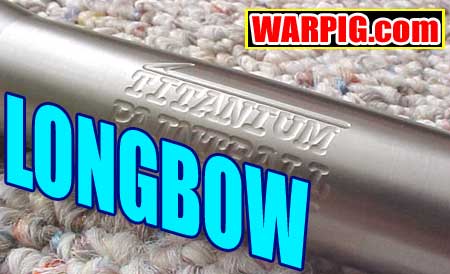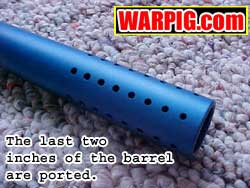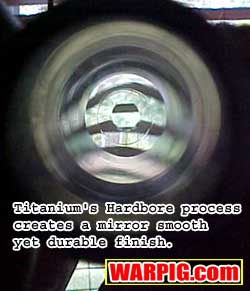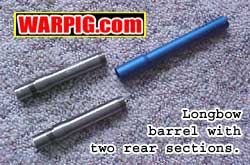
Titanium
Paintball
What
do you think?
Add
your comments in WARPIG's TECH TALK FORUMS.
|

Titanium Paintball’s
Longbow Barrel
By WARPIG.com Technical
Editor, Bill Mills
Titanium Paintball appeared on the paintball
scene in mid 2002 with their first product, the Longbow barrel system,
a two piece barrel with rear sections in various bore sizes.
Looking at the Longbow, it’s clear where
Titanium Paintball got their name. The rear section of the barrel
is machined of titanium alloy. While stainless steel has been a popular
material for the rear half of two piece barrels, titanium offers an attractive
alternative. Its material strength is very comparable to stainless
steel, yet is even more resistant to oxidation (even stainless steel can
rust), and significantly lighter in weight.
 The
barrel design is typical to two piece barrels in paintball. The overall
barrel length is twelve and a half inches, with a five and a half inch
rear control bore section. The aluminum second half of the barrel
is of a larger bore diameter, anodized aluminum with porting in its last
two inches. Titanium Paintball is planning future editions of the
barrel with a total of three porting patterns, one optimized for sound
reduction. The
barrel design is typical to two piece barrels in paintball. The overall
barrel length is twelve and a half inches, with a five and a half inch
rear control bore section. The aluminum second half of the barrel
is of a larger bore diameter, anodized aluminum with porting in its last
two inches. Titanium Paintball is planning future editions of the
barrel with a total of three porting patterns, one optimized for sound
reduction.  The
two segments are joined by a threaded connection that is different than
those from other manufacturers. Instead of the control bore piece
having a female threaded connection, it is male threaded, and screws into
the second half of the barrel. While this is unusual, it makes much
sense design wise. It allows the end of the control bore to be chamfered
so that it will self center its smaller bore to the larger bore of the
second half. The
two segments are joined by a threaded connection that is different than
those from other manufacturers. Instead of the control bore piece
having a female threaded connection, it is male threaded, and screws into
the second half of the barrel. While this is unusual, it makes much
sense design wise. It allows the end of the control bore to be chamfered
so that it will self center its smaller bore to the larger bore of the
second half.

A major manufacturing difference between
the Longbow and other barrels is that it is not honed. Most manufacturers
achieve their bore size and smoothness with a rotary hone. This is
a device that uses abrasives to grind and then polish the interior to exacting
specifications. While Titanium Paintball is tight lipped about the
methods of their process, they refer to it as hardbore finishing.
Titanium claims this finish is up to six times smoother than microhoning
and leaves a more durable surface. Looking down the barrel, one can
easily see the mirror-like scratch free finish. This surface has
mild waves (far different friction wise than surface roughness) that are
similar to the appearance of mandrel pressed barrels, where a plug is forced
through the barrel pressing and forcing the surface to a specific smoothed
diameter.
 The
Longbow barrel used for review featured a satin blue tip section, and control
bore sections in .684 and .689 inch inner diameters, which are in the middle
of the size Titanium Paintball has planned. Both control bore sections
were threaded with Autococker threads and the .684 was engraved with its
inner diameter and the Titanium Paintball logo was engraved on the side
(the .689 was sent for testing prior to its production batch getting label
engraving). The
Longbow barrel used for review featured a satin blue tip section, and control
bore sections in .684 and .689 inch inner diameters, which are in the middle
of the size Titanium Paintball has planned. Both control bore sections
were threaded with Autococker threads and the .684 was engraved with its
inner diameter and the Titanium Paintball logo was engraved on the side
(the .689 was sent for testing prior to its production batch getting label
engraving).
 Field
testing was performed with an Autococker, and Action Markers Sentinel,
both running on compressed air. A variety of paints were used, including
RP Scherer and DraXxus brands. Titanium Paintball’s philosophy is
that it is better to use the Longbow in a tighter size relative to the
paint, and rely on its low friction surface to get a tight seal against
the ball. At the chronograph, without adjusting the velocity settings
of the Autococker, paint that wedged into the barrel typically shot through
without breaking, but at a lower velocity than paint which just grabbed
at the barrel but could be easily blown through with lung power.
On the field, with both paintguns, after some intentional barrel breaks,
the Titanium barrel cleaned up with a squeegee as easily as most barrels,
but if shooting larger paint that fit tight into the .684 back, any debris
left behind in the barrel was likely to break another ball rather than
shoot through. Paint that closer matched the bore size shot straight
again within 5-10 shots after a barrel break, and on the next shot after
cleaning the barrel. Field
testing was performed with an Autococker, and Action Markers Sentinel,
both running on compressed air. A variety of paints were used, including
RP Scherer and DraXxus brands. Titanium Paintball’s philosophy is
that it is better to use the Longbow in a tighter size relative to the
paint, and rely on its low friction surface to get a tight seal against
the ball. At the chronograph, without adjusting the velocity settings
of the Autococker, paint that wedged into the barrel typically shot through
without breaking, but at a lower velocity than paint which just grabbed
at the barrel but could be easily blown through with lung power.
On the field, with both paintguns, after some intentional barrel breaks,
the Titanium barrel cleaned up with a squeegee as easily as most barrels,
but if shooting larger paint that fit tight into the .684 back, any debris
left behind in the barrel was likely to break another ball rather than
shoot through. Paint that closer matched the bore size shot straight
again within 5-10 shots after a barrel break, and on the next shot after
cleaning the barrel.
 In
all, the Longbow barrel performed well. It has the paint to barrel
matching benefits of a multi diameter barrel system, and is the first product
to combine that with the durability and weight factors of titanium which
is in and of itself an exotic metal that adds an extra coolness factor. In
all, the Longbow barrel performed well. It has the paint to barrel
matching benefits of a multi diameter barrel system, and is the first product
to combine that with the durability and weight factors of titanium which
is in and of itself an exotic metal that adds an extra coolness factor.
|





